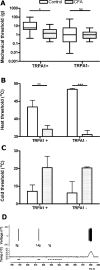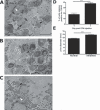Inflammation reduces mechanical thresholds in a population of transient receptor potential channel A1-expressing nociceptors in the rat
- PMID: 18598259
- PMCID: PMC2658012
- DOI: 10.1111/j.1460-9568.2008.06256.x
Inflammation reduces mechanical thresholds in a population of transient receptor potential channel A1-expressing nociceptors in the rat
Abstract
Inflammatory hypersensitivity is characterized by behavioural reductions in withdrawal thresholds to noxious stimuli. Although cutaneous primary afferent neurones are known to have lowered thermal thresholds in inflammation, whether their mechanical thresholds are altered remains controversial. The transient receptor potential channel A1 (TRPA1) is a receptor localized to putative nociceptive neurones and is implicated in mechanical and thermal nociception. Herein, we examined changes in the properties of single primary afferents in normal and acutely inflamed rats and determined whether specific nociceptive properties, particularly mechanical thresholds, are altered in the subpopulation of afferents that responded to the TRPA1 agonist cinnamaldehyde (TRPA1-positive afferents). TRPA1-positive afferents in normal animals belonged to the mechanonociceptive populations, many of which also responded to heat or capsaicin but only a few of which responded to cold. In acute inflammation, a greater proportion of afferents responded to cinnamaldehyde and an increased proportion of dorsal root ganglion neurones expressed TRPA1 protein. Functionally, in inflammation, TRPA1-positive afferents showed significantly reduced mechanical thresholds and enhanced activity to agonist stimulation. Inflammation altered thermal thresholds in both TRPA1-positive and TRPA1-negative afferents. Our data show that a subset of afferents is sensitized to mechanical stimulation by inflammation and that these afferents are defined by expression of TRPA1.
Figures




Similar articles
-
Transient receptor potential channel A1 and noxious cold responses in rat cutaneous nociceptors.Neuroscience. 2010 Feb 17;165(4):1412-9. doi: 10.1016/j.neuroscience.2009.11.065. Epub 2009 Dec 1. Neuroscience. 2010. PMID: 19961905 Free PMC article.
-
Intact Adelta-fibers up-regulate transient receptor potential A1 and contribute to cold hypersensitivity in neuropathic rats.Neuroscience. 2008 Jun 26;154(3):1054-66. doi: 10.1016/j.neuroscience.2008.04.039. Epub 2008 May 2. Neuroscience. 2008. PMID: 18514429 Free PMC article.
-
Transient receptor potential channel A1 involved in sensory transduction of rat urinary bladder through C-fiber pathway.Urology. 2007 Oct;70(4):826-31. doi: 10.1016/j.urology.2007.06.1110. Urology. 2007. PMID: 17991581
-
How cold is it? TRPM8 and TRPA1 in the molecular logic of cold sensation.Mol Pain. 2005 Apr 22;1:16. doi: 10.1186/1744-8069-1-16. Mol Pain. 2005. PMID: 15847696 Free PMC article. Review.
-
The dynamic TRPA1 channel: a suitable pharmacological pain target?Curr Pharm Biotechnol. 2011 Oct;12(10):1689-97. doi: 10.2174/138920111798357302. Curr Pharm Biotechnol. 2011. PMID: 21466445 Free PMC article. Review.
Cited by
-
Neonatal colon insult alters growth factor expression and TRPA1 responses in adult mice.Pain. 2010 Nov;151(2):540-549. doi: 10.1016/j.pain.2010.08.029. Epub 2010 Sep 17. Pain. 2010. PMID: 20850221 Free PMC article.
-
TRPA1 Antagonists for Pain Relief.Pharmaceuticals (Basel). 2018 Nov 1;11(4):117. doi: 10.3390/ph11040117. Pharmaceuticals (Basel). 2018. PMID: 30388732 Free PMC article. Review.
-
The consequence of endothelial remodelling on the blood spinal cord barrier and nociception.Curr Res Physiol. 2022 Apr 4;5:184-192. doi: 10.1016/j.crphys.2022.03.005. eCollection 2022. Curr Res Physiol. 2022. PMID: 35434652 Free PMC article. Review.
-
The transient receptor potential channel TRPA1: from gene to pathophysiology.Pflugers Arch. 2012 Nov;464(5):425-58. doi: 10.1007/s00424-012-1158-z. Epub 2012 Sep 22. Pflugers Arch. 2012. PMID: 23001121 Review.
-
TRPA1 modulation of spontaneous and mechanically evoked firing of spinal neurons in uninjured, osteoarthritic, and inflamed rats.Mol Pain. 2010 Mar 5;6:14. doi: 10.1186/1744-8069-6-14. Mol Pain. 2010. PMID: 20205719 Free PMC article.
References
-
- Ahlgren SC, Wang JF, Levine JD. C-fiber mechanical stimulus-response functions are different in inflammatory versus neuropathic hyperalgesia in the rat. Neuroscience. 1997;76:285–290. - PubMed
-
- Ando R, Yonezawa A, Watanabe C, Kawamura S. An assessment of vascular pain using the flexor reflex in anesthetized rats. Methods Find. Exp. Clin. Pharmacol. 2004;26:109–115. - PubMed
-
- Andrew D, Greenspan JD. Mechanical and heat sensitization of cutaneous nociceptors after peripheral inflammation in the rat. J. Neurophysiol. 1999;82:2649–2656. - PubMed
-
- Bandell M, Story GM, Hwang SW, Viswanath V, Eid SR, Petrus MJ, Earley TJ, Patapoutian A. Noxious cold ion channel TRPA1 is activated by pungent compounds and bradykinin. Neuron. 2004;41:849–857. - PubMed
Publication types
MeSH terms
Substances
Grants and funding
LinkOut - more resources
Full Text Sources
Other Literature Sources

